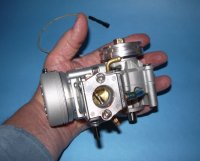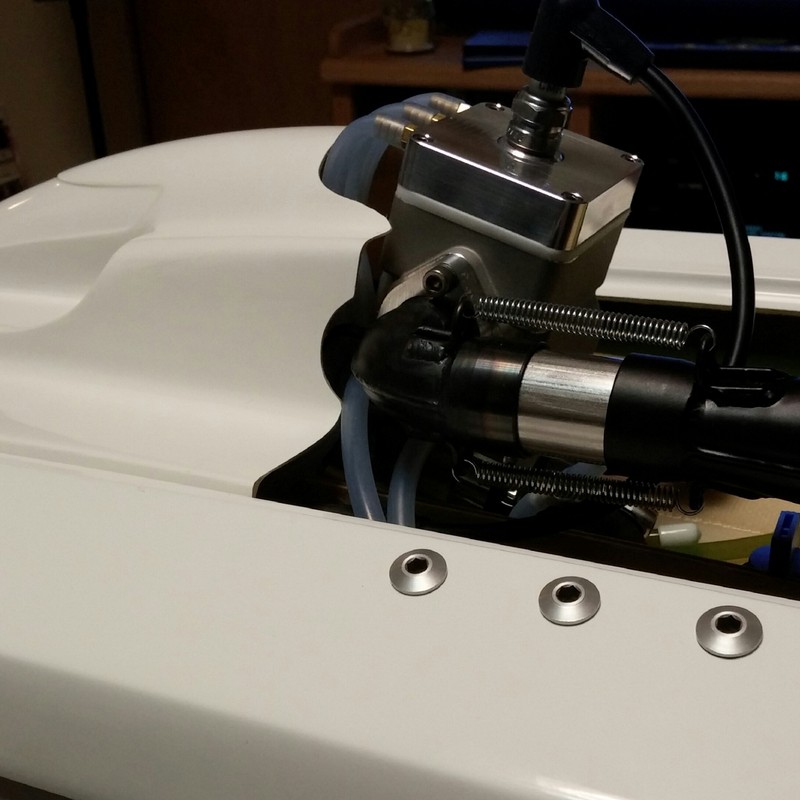Looking forward
Hot Rods created the topic: Looking forward
From this and other forums, it seems there's more and more interest and work being done, to make our engine's bottom ends a lot more bullet proof for extreme RPM. Certainly, the rotating assemblies are starting to show weakness with larger masses and longer strokes, and so that's the place to start improving. While for some, that's obvious. But I wonder, and hope to start a dialogue, about " beyond the bottom end. "
I would hope that if there is any interest, that we keep our focus on our little ( 25 to 30 cc. ) engines, rather than larger cyld. Karts, PWC, snow machine, or motorcycle formats.
Our model boat engines ( unlike any other enclosed marine engines ) operate at extreme RPM, and can and will, take a gulp of water in an instant. If we produce totally bulletproof bottom ends ( piston/rod/bearings/cranks ), what will "let go" when the water tries to compress? Will a very expensive custom ported aluminum cyld. crack or blow off the case? Will a separate head button let go? That's all part of game we play, but I guess we need to choose how far to go with each part, and where to assign the "weak link". What about some kind of a safety "pop-off valve" somewhere? ( just a crazy thought )
Looking at cylds. for these extreme bottom ends, I wonder how much, if any, research/flow work is being done to make these little cylds. breath at those RPM levels. Will we see as much effort in this area as we are on the cases? At the moment, QD seems to be the "pioneer" at flow study and production of improved design cylds., but is the tiny commercial market going to tolerate all the custom product to come?
Even at the present time, we can produce one-off engs. with state of the art electronic ign. systems, very low rotating mass, small footprints, and good/reliable power. They won't breath very well beyond 21,000, even with the best available cylds. BUT, there is NO commercial market for such an animal.
So, how far do we go to make improvements, and will other components keep up, while trying to keep the general buyer interested?
Or will these high end machines stay as one-off project/record type engs?
Anyway,I would like to hear any ideas, or small eng. flow work that some of you may be thinking about ( don't need specifics ).
If there is any discussion, let's try to keep it just opinion, and not argumentative.
I would hope that if there is any interest, that we keep our focus on our little ( 25 to 30 cc. ) engines, rather than larger cyld. Karts, PWC, snow machine, or motorcycle formats.
Our model boat engines ( unlike any other enclosed marine engines ) operate at extreme RPM, and can and will, take a gulp of water in an instant. If we produce totally bulletproof bottom ends ( piston/rod/bearings/cranks ), what will "let go" when the water tries to compress? Will a very expensive custom ported aluminum cyld. crack or blow off the case? Will a separate head button let go? That's all part of game we play, but I guess we need to choose how far to go with each part, and where to assign the "weak link". What about some kind of a safety "pop-off valve" somewhere? ( just a crazy thought )
Looking at cylds. for these extreme bottom ends, I wonder how much, if any, research/flow work is being done to make these little cylds. breath at those RPM levels. Will we see as much effort in this area as we are on the cases? At the moment, QD seems to be the "pioneer" at flow study and production of improved design cylds., but is the tiny commercial market going to tolerate all the custom product to come?
Even at the present time, we can produce one-off engs. with state of the art electronic ign. systems, very low rotating mass, small footprints, and good/reliable power. They won't breath very well beyond 21,000, even with the best available cylds. BUT, there is NO commercial market for such an animal.
So, how far do we go to make improvements, and will other components keep up, while trying to keep the general buyer interested?
Or will these high end machines stay as one-off project/record type engs?
Anyway,I would like to hear any ideas, or small eng. flow work that some of you may be thinking about ( don't need specifics ).
If there is any discussion, let's try to keep it just opinion, and not argumentative.
Please Log in or Create an account to join the conversation.
- Hot Rods
-
 Topic Author
Topic Author
- Offline
- Posts: 164
- Karma: -5
- Thank you received: 36
SRI Motorsports replied the topic: Looking forward
What has my curiosity is how much more can our little utility ign systems can handle? Coils need a certain amount of time to re charge after firing and with 25-30k on the menu in the near future what will happen? Is everyone going to maake the conversion to power spark? With these super strength rotating assem do you think this rpm is sustainable with stock heavy flywheel weights and magnetic drag? The answer is simple.... its hard enough for people now to follow rules and advice. What will happen if a manufacture states you have to run this and you cant do that. No one will be intrested. Everyone except a small amount of people want to bolt it in and use the same stuff as now for support equip. In my opinion like it or not, this type of eng if avail to public wouldn't last long. Bad feed back from lack of proper maintainance will appear and no one will buy such an animal because of the requirements that come along. I see it now all the time and people get mad at the builder that their eng didn't last or whatever else. It all come down to KISS. However, i would like to see this eng built and know what cyl will support flow at the rpm stated now days and be economical for the average joe.
Peter Somers
SRI Motorsports
Lazer 40 LSG27 + LSG36 SAW
Last edit: 12 years 1 week ago by SRI Motorsports. Reason: more added
Please Log in or Create an account to join the conversation.
- SRI Motorsports
-

- Offline
- Posts: 61
- Thank you received: 7
Hot Rods replied the topic: Looking forward
Just to go back to that "crazy idea" thing; I wonder if we could develop a "break-away" fastener system for head buttons that would allow the button to lift slightly into the cooling cap to relieve the water pressure of a gulp? Obviously that pressure would be several times higher than normal compression, and the fasteners would have to be replaced after one incident. Breakaway studs perhaps? There could still be some button or top of the sleeve damage, but maybe not the loss of a complete eng. We are talking very expensive engs. here. Could be expensive testing to get there LOL.
As I said, crazy idea.
As I said, crazy idea.
Please Log in or Create an account to join the conversation.
- Hot Rods
-
 Topic Author
Topic Author
- Offline
- Posts: 164
- Karma: -5
- Thank you received: 36
SRI Motorsports replied the topic: Looking forward
You want me to put a slight notch in all my QD studs for this cause? LOL. 5min of time and problem solved. Not so crazy now is it...
Peter Somers
SRI Motorsports
Lazer 40 LSG27 + LSG36 SAW
Last edit: 12 years 6 days ago by SRI Motorsports. Reason: additional text
Please Log in or Create an account to join the conversation.
- SRI Motorsports
-

- Offline
- Posts: 61
- Thank you received: 7
Hot Rods replied the topic: Looking forward
LOL Not until ya detonate it on 42 degrees of PowerSpark!
Please Log in or Create an account to join the conversation.
- Hot Rods
-
 Topic Author
Topic Author
- Offline
- Posts: 164
- Karma: -5
- Thank you received: 36
Canadian Hot Rod RC Boats replied the topic: Looking forward
Roots type superchargers have ran "blow off studs" for years .. maybe someone will make you a set or two
www.summitracing.com/int/parts...82win/overview/
www.summitracing.com/int/parts...82win/overview/
Zoom Zoom .....
Toy Boats Toy Boats
Misty Creek Boats
www.youtube.com/channel/UCjwPZIU4nBUUk1CG0xf3TnQ
Please Log in or Create an account to join the conversation.
- Canadian Hot Rod RC Boats
-

- Offline
- Posts: 959
- Karma: 12
- Thank you received: 68
Time to create page: 0.102 seconds
